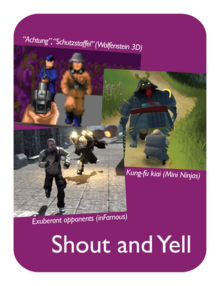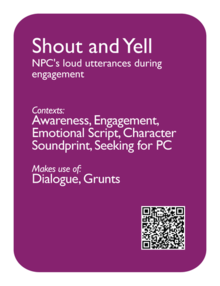Difference between revisions of "Shout and Yell"
From SoundInGames.com - Sound Design in Games
ValterAlves (Talk | contribs) m |
ValterAlves (Talk | contribs) m |
||
| Line 2: | Line 2: | ||
| name =Shout and Yell | | name =Shout and Yell | ||
| deckversion =1.0 | | deckversion =1.0 | ||
| − | | | + | | v10synopsis =NPC’s loud utterances during engagement |
| + | | v20synopsis =Loud manifestations of hostility | ||
| patternpresentation = | | patternpresentation = | ||
| cardpresentation= | | cardpresentation= | ||
Revision as of 18:25, 17 November 2011

|

| |
| The card's front face | The card's back face |
Contents
Synopsis
| Loud manifestations of hostility. |
Relationships
Contexts:
Awareness ![]() , Engagement
, Engagement ![]() , Emotional Script
, Emotional Script ![]() , Character Soundprint
, Character Soundprint ![]() , Seeking for PC
, Seeking for PC ![]() .
.
Makes use of:
Dialogue ![]() , Grunts
, Grunts ![]() .
.
Description
Shout and Yell refers to loud expressions, either Grunts or Dialogue-like, that a character emits with the evident purpose of messaging an hostile attitude towards others (usually NPC towards the PC, but not necessarily).
A particular (an much less common) exploration of Shout and Yell is when it is integrated in the Gameplay in association with the Sound Input.
Examples
  Wolfenstein 3-D: The use of Shout and Yell in this game is emblematic. It is this game's most well known Signature.
|








